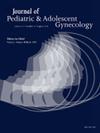49. Hormonal contraceptive considerations in the setting of venous thromboembolism and absent inferior vena cava: A case report
IF 1.7
4区 医学
Q3 OBSTETRICS & GYNECOLOGY
引用次数: 0
Abstract
Background
Venous thromboembolism (VTE) risk among users of contraception varies based on the hormonal composition of each method. Controversy exists regarding the use of hormonal contraception in those with a history of thrombosis or thrombophilia and require anticoagulation therapy.
Case
A 17 y.o. girl presented with persistent pain and swelling in both of her legs. Ultrasound confirmed bilateral femoral vein thromboses; CT revealed absence of the inferior vena cava (AIVC) with extensive thromboses through the iliac and femoral veins. She received therapeutic anticoagulation and mechanical thrombectomy. She reported a history of heavy menses and desired to initiate hormonal contraception for mitigation of heavy menstrual bleeding ultimately choosing the drospirenone 4mg contraceptive pill.
Comments
AIVC is a rare anomaly that affects < 1% of the population but commonly presents with lower extremity DVTs in young adults, requiring long-term or indefinite anticoagulation due to high rates of recurrence. Anticoagulation use in menstruating individuals has been associated with increased rates of abnormal uterine bleeding. Yet, there is some reluctance amongst health care providers to prescribe hormonal contraception in these circumstances due to increased risk of VTE, particularly with estrogen-containing methods. 2024 guidelines stratify risk based on: 1) current or history of VTE receiving therapeutic dosing of anticoagulants, 2) history of VTE receiving prophylactic dosing of anticoagulants without or with higher risk of recurrent VTE, and 3) history of VTE not receiving prophylactic dosing of anticoagulants. Though combination hormonal contraceptives (CHCs) do not appear to be associated with increased risk of recurrent VTE in those receiving anticoagulation therapy, CHCs are considered to have unacceptable risk in those with a high risk of recurrent VTE. Vascular malformations such as AIVC result in venous stasis and an increased risk of VTE with CHC use. In contrast, the menstrual and contraceptive benefits of progestin-only pills (POPs), the etonorgestrel implant, and the 52-mg levonorgestrel-releasing IUD (LnGIUD) usually outweigh the risk of recurrent VTE. A POP was deemed the most favorable option when prioritizing management of heavy bleeding in our patient given the possibility of breakthrough bleeding after initiation of LnGIUD, and the risk of irregular menstrual bleeding with the etonogestrel implant. Our patient chose the drospirenone 4mg contraceptive pill which may provide a more favorable bleeding profile with significantly lower rates of unscheduled bleeding compared to traditional POPs.
49. 静脉血栓栓塞和下腔静脉缺失的情况下激素避孕的考虑:1例报告
背景:静脉血栓栓塞(VTE)的风险在避孕使用者之间的差异取决于每种方法的激素组成。对于有血栓形成或血栓形成病史并需要抗凝治疗的患者,激素避孕存在争议。病例一名十七岁女孩表现为两腿持续疼痛和肿胀。超声证实双侧股静脉血栓形成;CT显示下腔静脉(AIVC)缺失伴髂静脉和股静脉广泛血栓形成。她接受了抗凝治疗和机械取栓术。她报告有月经量大的病史,希望开始激素避孕以减轻月经量大出血,最终选择了4毫克的螺螺酮避孕药。评论:vc是影响<;占人口的1%,但通常表现为年轻人下肢深静脉血栓,由于复发率高,需要长期或无限期抗凝。经期个体使用抗凝剂与异常子宫出血率增加有关。然而,在这些情况下,由于静脉血栓栓塞的风险增加,特别是含有雌激素的方法,卫生保健提供者不愿意开激素避孕。2024指南根据以下因素对风险进行分层:1)静脉血栓栓塞患者目前或既往接受治疗性剂量的抗凝药物治疗;2)静脉血栓栓塞患者接受预防性剂量的抗凝药物治疗,且无或有较高的静脉血栓栓塞复发风险;3)静脉血栓栓塞患者未接受预防性剂量的抗凝药物治疗。虽然在接受抗凝治疗的患者中,联合激素避孕药(CHCs)似乎与静脉血栓栓塞复发风险增加无关,但CHCs在静脉血栓栓塞复发风险高的患者中被认为具有不可接受的风险。血管畸形,如AIVC,导致静脉淤滞和使用CHC时静脉血栓栓塞的风险增加。相比之下,单孕激素避孕药(pop)、炔诺孕酮植入物和52毫克左炔诺孕酮释放宫内节育器(lgiud)的月经和避孕益处通常大于静脉血栓栓塞复发的风险。考虑到输尿管内节育器启动后可能出现突破性出血,以及使用炔诺孕酮植入物导致月经不规则出血的风险,在优先处理患者大出血时,POP被认为是最有利的选择。我们的患者选择了4毫克的降螺酮避孕药,与传统的持久性有机污染物相比,它可能提供更有利的出血情况,显著降低了计划外出血的发生率。
本文章由计算机程序翻译,如有差异,请以英文原文为准。
求助全文
约1分钟内获得全文
求助全文
来源期刊
CiteScore
3.90
自引率
11.10%
发文量
251
审稿时长
57 days
期刊介绍:
Journal of Pediatric and Adolescent Gynecology includes all aspects of clinical and basic science research in pediatric and adolescent gynecology. The Journal draws on expertise from a variety of disciplines including pediatrics, obstetrics and gynecology, reproduction and gynecology, reproductive and pediatric endocrinology, genetics, and molecular biology.
The Journal of Pediatric and Adolescent Gynecology features original studies, review articles, book and literature reviews, letters to the editor, and communications in brief. It is an essential resource for the libraries of OB/GYN specialists, as well as pediatricians and primary care physicians.

 求助内容:
求助内容: 应助结果提醒方式:
应助结果提醒方式:


